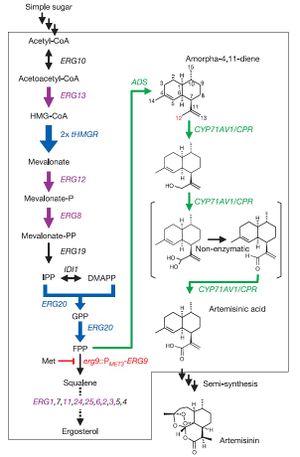CH391L/S12/Artemisinic Acid Engineering: Difference between revisions
No edit summary |
No edit summary |
||
| Line 12: | Line 12: | ||
==Artemisinin== | ==Artemisinin== | ||
[[Image:Artemisinin.png|thumb|right|Chemical Structure of Artemisinin. Image from Wikipedia Commons.]] | [[Image:Artemisinin.png|thumb|right|Chemical Structure of Artemisinin. Image from Wikipedia Commons.]] | ||
Aretmisinin, or Qinghaosu, is a chemical compound produced naturally by the plant <i>Artemsia annua</i>. It is a | Aretmisinin, or Qinghaosu, is a chemical compound produced naturally by the plant <i>Artemsia annua</i>. It is a sesquiterpene lactone, a type of terpene derived from 3 Isoprene units and a lactone ring. The compound is unique, as it contains a peroxide bridge and no Nitrogen atoms. It was first derived from <i>Artemsia annua</i> in 1971 by Chinese chemists interested in observing the plant's supposed use in curing headaches <cite>Klayman1985</cite>. | ||
Previously, one of the most widely used antimalarial drugs produced was chloroquine. While successful at combating malaria, chloroquine exhibits multiple adverse side effects, most notably Pruritus. Pruritus is a particularly uncomfrotable form of itching sensation that dark-skinned individuals are more susceptible to, due to their increased melanocytes and the pathway in which chloroquine binds to these melanocytes<cite>Aghahowa2010</cite>. This condition can be so painful that multiple drugs must be administered in unison with chloroquine in order to negate its detrimental side-effects | |||
==Production Procedure== | ==Production Procedure== | ||
| Line 26: | Line 28: | ||
<biblio> | <biblio> | ||
#Klayman1985 pmid=3887571 | #Klayman1985 pmid=3887571 | ||
// | |||
#Aghahowa2010 pmid=21188034 | |||
// | // | ||
Revision as of 15:05, 8 April 2012
- NOTE* Page is still under construction. As long as this note appears, assume information presented on this page is incomplete and unreliable.
Artemisia

Artemisia is a genus that encompass a broad range of plants commonly known as sagebrush, sagewort, and wormwood. The family, which derives its name from the either from the Greek goddess Artemis or Artemisia, the wife of Mausolus, includes many famous plants. Artemisia absinthium is used in the production of Absinthe, and Shakespeare employed wormwood as a cure for the love potion in Midsummer's Night Dream. One species of Artemisia, known as Artemsia annua, has been used for thousands of years in traditional Chinese medicines to cure headaches.
This last species is of particular interest to synthetic biologists, due to its ability to produce Artemisinin. As a result, much of the species' genes have been characterized and submitted to the Gene Bank.
Artemisinin

Aretmisinin, or Qinghaosu, is a chemical compound produced naturally by the plant Artemsia annua. It is a sesquiterpene lactone, a type of terpene derived from 3 Isoprene units and a lactone ring. The compound is unique, as it contains a peroxide bridge and no Nitrogen atoms. It was first derived from Artemsia annua in 1971 by Chinese chemists interested in observing the plant's supposed use in curing headaches [1].
Previously, one of the most widely used antimalarial drugs produced was chloroquine. While successful at combating malaria, chloroquine exhibits multiple adverse side effects, most notably Pruritus. Pruritus is a particularly uncomfrotable form of itching sensation that dark-skinned individuals are more susceptible to, due to their increased melanocytes and the pathway in which chloroquine binds to these melanocytes[2]. This condition can be so painful that multiple drugs must be administered in unison with chloroquine in order to negate its detrimental side-effects
Production Procedure

In a famous paper released by Ro et al., Saccharomyces cerevisiae was engineered to produce artemisinic acid from simple sugars.
Previous iGEM Examples
There has been no incidence of previous iGEM teams investigating Artemisinin or any of its precursors. Many iGEM teams have referenced Ro et al., but only as an example of pathway engineering, or in order to discuss ethics and synthetic biology's potential to positively benefit society. No parts in the parts registry deals with Artemisinin either. Only one [set of parts] mentions a protein, Granulysin, which can potentially be used to fight Malaria.
References
- Klayman DL. Qinghaosu (artemisinin): an antimalarial drug from China. Science. 1985 May 31;228(4703):1049-55. DOI:10.1126/science.3887571 |
- Aghahowa SE, Obianwu HO, Isah AO, and Arhewoh IM. Chloroquine-induced Pruritus. Indian J Pharm Sci. 2010 May;72(3):283-9. DOI:10.4103/0250-474X.70471 |
- Ro DK, Paradise EM, Ouellet M, Fisher KJ, Newman KL, Ndungu JM, Ho KA, Eachus RA, Ham TS, Kirby J, Chang MC, Withers ST, Shiba Y, Sarpong R, and Keasling JD. Production of the antimalarial drug precursor artemisinic acid in engineered yeast. Nature. 2006 Apr 13;440(7086):940-3. DOI:10.1038/nature04640 |